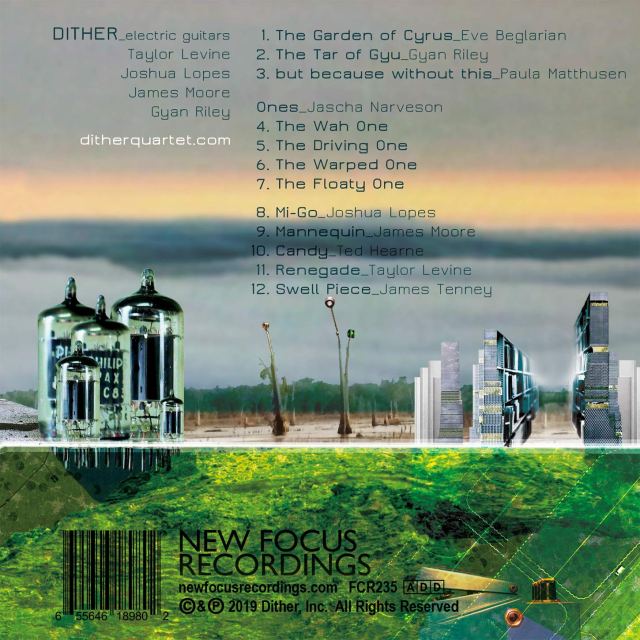Dither is a guitar quartet comprised of Taylor Levine, Joshua Lopes, James Moore and Gyan Riley. The present release is their third album and, like the preceding releases is an adventure in listening. Their intelligently designed web site has some nice sound and video samples.
A quick look at their recorded output places their performing repertoire clearly in the “new music” category and their work has been granted a kind of serious legitimacy by their inclusion (of their second album) in John Zorn’s wonderful Tzadik record label. So along comes the truly rising star of New Focus Recordings whose service to new music adds yet another imprimatur to this group’s collective resume.

A quick look at the track list on the back of this gorgeously designed album reveals 9 works spread across 12 tracks (one of the works is in 4 movements) which includes one track from each of the musicians alongside some other interesting new music and, at the end, the gift of one older piece which, though certainly modern in concept is too little known. The only negative is the lack of liner notes both on the album and on their website.
I assure you that I don’t mean to trivialize this wonderful album by calling it “post-psychedelic” but it is difficult to not hear the riffs and effects as having an ancestry in the psychedelic sound. But for this disc the psychedelic sounds appear to include Frank Zappa, Rhys Chatham, La Monte Young, Brian Eno, as well as Jimi Hendrix, Mahavishnu John Mc Laughlin, and their compatriots.
The first track, “The Garden of Cyrus” (1985) by Eve Beglarian, a much sought after composer who emerged from the downtown New York scene and continues to enthrall with her inventive talents. This track is generally speaking a sort of post minimalist piece with a rather immediate appeal and serves as a fine introduction to the album. It has a variety of sections with varying degrees of rhythmic complexity and harmonic density. It is sometimes microtonal, sometimes spectral, sometimes antiphonal, sometimes dissonant, sometimes warmly consonant, but always engaging.
Next up is “The Tar of Gyu” (2013) by Gyan Riley. Gyan is indeed his own man musically who has emerged from the shadow of his famed father Terry Riley in a most gracious manner. His collaborations with his father continue to be a must see concert event and his work in solo and chamber groups reflect a growing and fascinating identity as a composer and musician entirely in his own right. The present work makes excellent use of the timbres of the electric guitar and makes for another engaging if rather somber track. This work is largely about sustained tones and timbres and shows a real mastery of composing for this unusual chamber ensemble as well as a side of Riley’s compositional style less familiar to this reviewer.
Paula Matthusen, an associate professor of music at Wesleyan where she became the sort of heir to Alvin Lucier’s Music 109 class (documented so well in Lucier’s book of the same name). Her music combines electronics with instruments and sometimes recorded sounds. Her piece, “but because without this” (2009) was written for Dither and continues her unique compositional journey. Without notes it is difficult to say much about this work by a composer who tends to insert herself pretty organically into her compositions.
Jascha Narveson is a name new to this reviewer. He is another composer deeply involved with electronics as well as acoustic instruments. Ones (2012) is a four movement work written for the Dither Quartet. This is basically a set of etudes for the effects pedal. The four movements, titled “The Wah One”, “The Driving One”, “The Warped One”, and “The Floaty One” are each apparently a reference to electric guitar foot pedals and these minimalist etudes exploit the effect created by the pedal as a compositional device. Really fascinating.
Mi-Go (2012) by the ensemble’s own Joshua Lopes and it is here that the Zappa comparison is most evident. This piece (the second longest on the album at 9:38) sounds like an aural refugee from Zappa’s “Jazz from Hell” (an album much admired by this writer). Lopes creates a work of some complexity and many moods utilizing the potential of this instrumentation to great advantage creating a work of almost symphonic dimensions.
Up next is James Moore’s Mannequin (2014), one of the shorter pieces here. After a loud and somewhat cacophonous opening this piece goes on to explore sustained tones and glissandos.
Candy (2010) by Ted Hearne is the first of only two pieces here that was not written by one of the performers. Hearned earlier released a fine disc of his own music (also on New Focus). Like many of his peers he wields a tool box of compositional styles that includes jazz as well as contemporary classical techniques. This is certainly one of the more complex pieces here but Hearne’s music communicates well with the audience.
Track 11 is by Dither’s Taylor Levine. Renegade (2013) is a relatively brief piece and one which wanders furthest from my characterization of this album being “minimalist”. It seems to have its roots at least partly in noise bands but its complexity engages and seems to fit the program.
Track 12 is by James Tenney (1934-2006). His Swell Piece (1966) is actually an early example of minimalism an is part of a series of compositions written on post cards and called, “Postal Pieces”. Tenney spent a portion of his career in California teaching at Cal Arts where he mentored many composers and performers working today, This is a fitting conclusion, an homage to one of the great experimental composers whose music, thankfully, is now getting fine performances and recordings.